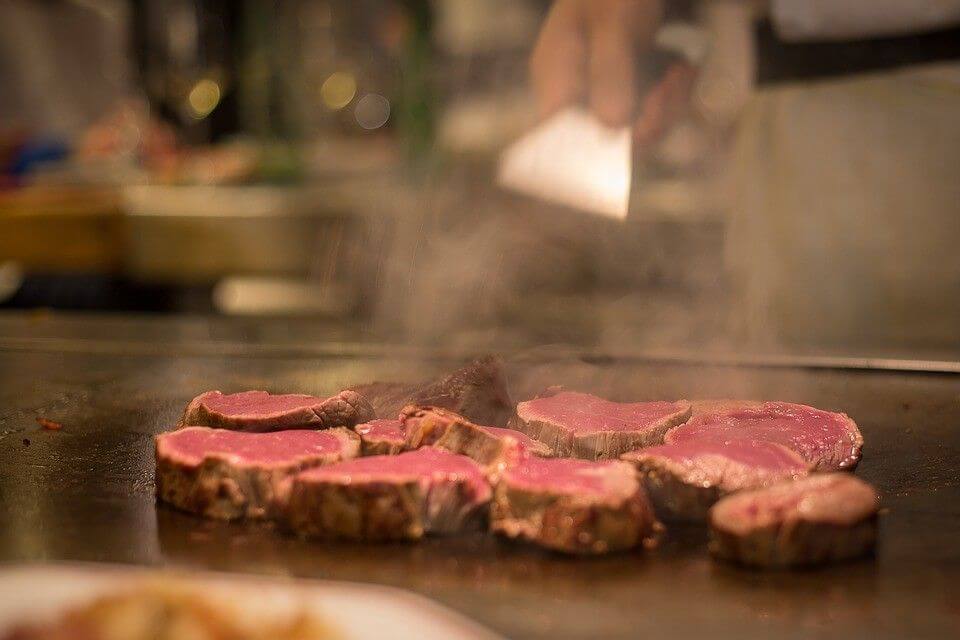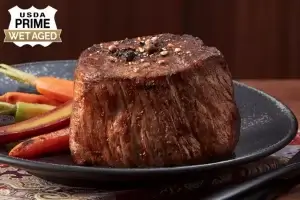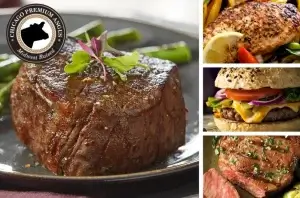
Photo by Max Pixel licensed under CC0 1.0
When you order a steak from a restaurant, you’re blessed with having the finished product on your plate and ready to eat. You tell the waiter or waitress the level of doneness you’d like your beef, they relay that to the chef, and you get a perfectly cooked steak done to your liking.
If you’ve cooked steaks at home and aren’t a master chef, then you know it’s not as easy to replicate the process in your own kitchen. Steaks can become overdone quickly, and they can also trick you into thinking they’re done enough. Cooking times also vary depending on the cookware and cooking method you use.
How, then, are you supposed to know when a steak’s done? The Chicago Steak Company experts are here to help you out with this guide to getting the steaks cooked to your desired temperature.
Table of Contents
Is One Steak Temperature Better Than Another?
First, let’s cover the hot debate of what the best level of doneness for steak is. While some people like a slight pink hue in the center of their steaks, others like them practically mooing. Although most of it boils down to personal preference, there also is some science that goes on when you cook a steak that could make it taste better the more cooked it is.
Most steaks are best at medium-rare to medium. These temperatures cause the fat within the cuts to render, which allows the flavor from fat to move throughout the steak and keep it tender. Cooking only to rare doesn’t give the steak quite enough time to benefit from this process, and cooking to well-done can cause the meat to become chewy and lose that tenderness that steak’s known for.
Your Guide to Steak Temperature Doneness Levels
When it comes to cooking a steak, there are several doneness levels to choose from. The beauty of experimenting with steak temperatures is that each one leads to a different end result in terms of flavor and texture. While some prefer more well done steaks, others prefer pinker, juicier steaks. Here’s what you need to know about steak doneness levels:
Blue Steak
Blue steak, also known as blue rare steak, is one you don’t hear about as often as others, like rare steak and medium rare steak, but it exists nonetheless. Blue steak has roots in French cuisine, and it’s even rarer than rare. When chefs cook blue steak, they simply sear the outside to get a nice crisp and yummy flavor. The inside remains raw, although slightly elevated in temperature, with a purplish-red center. This steak only gets cooked to 108℉.
Rare
A rare steak has a center that’s cooked a bit, so it becomes a deep red and very juicy when it’s done. The internal temperature of a rare steak falls between 120 and 120℉. Rare steak does not need to be cooked for very long, but it’s still somewhat warm in the middle. To achieve a rare internal temperature, you’ll remove the steak when it reaches 115℉.
Medium Rare
Medium rare steak is the golden standard. This is the most common steak doneness to order at a restaurant and cook at home. A medium rare steak has a warm, red center, making the meat have more of that tell-tale steak texture than blue steak and rare steak. The outer edges of the center will fade to a dark pink, but the inside itself is a deep, juicy red. Remove a medium rare steak from the heat when it reaches 125℉.
Medium
With medium steak, you’ll see no red in the center. Instead, the meat is pink and warm, and you’ll see only a light pink around the edges of the steak’s center. This doneness level is a popular option for people who prefer not to bite into red or have too many juices flowing out of the meat. Medium steaks need to come off the heat when they reach 135℉.
Medium Well
Medium well has a center that’s only lightly pink, and there’s little to no pink color on the outer edges of the meat. The core temperature is, on average, about 155℉ when fully cooked, but you’ll need to remove it from the heat when it reaches 145℉.
Well Done
Well done steaks get cooked to 155℉, making their centers have little to no pink color. Medium well and well done steaks can be tricky to perfect, as overcooking them can lead to chewy and dry meat.
How to Temp Steaks the Right Way
The absolute best way to get an accurate temperature of steak is to use a reliable digital meat thermometer to do the job. The temperature should be quick-reading to make sure you’re not risking overcooking the meat while you wait for the reading. Here’s how to get an accurate temperature read for your steak using a thermometer:
- Find the thickest part of the steak, as this will be the coolest part of the steak. You’ll want this reading to make sure that the inside of the steak is cooked to your ideal doneness level.
- Insert the thermometer’s probe into that thick part on a slight angle. Continue moving the probe further into the steak. The temperature will drop, but this is what you want; this temperature lets you know where the coolest part of the steak is and whether it’s at the temperature you’d like it to be.
- Once the temperature stops moving, you can determine from that temperature whether you need to cook the steak a bit more or it’s safe to remove from the oven, grill, or pan. Remember to use the steak temperatures chart below to find the ideal temperature for removing the steak, as it continues to cook a bit while it rests.
No Thermometer? Use the Hand Method
If a thermometer isn’t available, you might still be able to check the level of doneness of your steak by using your hand. It’s not as accurate as a temperature, but it’s better than nothing.
Press two fingers gently into the surface of the middle of the beef. Then, feel press those same fingers into the palm of your hand right underneath your thumb as you touch the thumb to each finger. The squishiness of that muscle will differ as your thumb touches each finger and can give you an idea of your meat’s doneness. Thumb to index finger is rare, thumb to middle finger is medium-rare, thumb to ring finger is medium and thumb to pinky finger is well-done.
Remember only to use this method as a last resort. It’s better than judging your steak’s doneness by color (color is open to interpretation). But, a fast-read digital meat thermometer is best, so it’s a good idea to consider buying one if you plan to cook steak often.
Doneness Temperatures vs Cooking Temperatures
It’s crucial to remember that the steak temperature for your level of doneness is not the same as the internal temperature you’ll want to cook your steaks. Instead, you should remove steaks when they’re about 5-degrees Fahrenheit away from your desired temperature, as the steaks will continue to cook for a few minutes after removed from the grill.
Follow this handy guide for steak doneness vs cooking temperatures to help you get the perfect cook:
Steak Doneness Chart |
|||
| Steak Doneness | Temperature (F) | Temperature (Celsius) | Notes |
| Blue Steak | 110 – 115° F | 43 – 46° C | cooler purplish center. Remove when it reaches 108° F |
| Rare | 120 – 125° F | 49 – 52° C | Cooler red center Remove when it reaches 115° F |
| Medium Rare | 130 – 135° F | 54 – 57° C | Most popular, warm red center. Remove when it reaches 125° F |
| Medium | 140 – 145° F | 60 – 63° C | Warm pink center, less pink around the edges. Remove when it reaches 135° F |
| Medium Well | 150 – 160° F | 65 – 71° C | Light pink center with little color on the edges. Remove when it reaches 145° F |
| Well Done | 160 – 170° F | 71 – 77° C | Center has little to no pick. Remove when it reaches 155° F |
It’s tempting to want to cut right into your steak to check the inside and see if it’s done to your liking, but refrain from doing this until you let your meat rest for about 10 minutes. This rest period gives the steak time to get its juices flowing back through the meat and finish cooking to your liking.
Conclusion: Steak Temperatures
Stop guessing when it comes to cooking your beef the way you want it. Not much is worse than spending good money on steaks only to overcook them! Order some of your favorite Chicago Steak Company steaks, get them shipped to your door, and cook them with confidence using this helpful guide.



